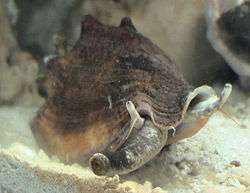Strombus alatus
| Strombus alatus | |
|---|---|
 | |
| Front view of Strombus alatus showing the snout in front and stalked eyes behind, one of which reaches out through the stromboid notch in the shell | |
| | |
| Scientific classification | |
| Kingdom: | Animalia |
| Phylum: | Mollusca |
| Class: | Gastropoda |
| (unranked): | clade Caenogastropoda clade Hypsogastropoda |
| Superfamily: | Stromboidea |
| Family: | Strombidae |
| Genus: | Strombus |
| Species: | S. alatus |
| Binomial name | |
| Strombus alatus (Gmelin, 1791) | |
| Synonyms | |
|
Strombus crenulatus Röding, 1798 | |
Strombus alatus, common name the "Florida fighting conch" is a species of medium-sized warm-water sea snail, a marine gastropod mollusk in the family Strombidae, the true conchs.
Distribution
This conch occurs in the Western Atlantic Ocean from North Carolina throughout Florida and the Gulf of Mexico, Louisiana, Texas and the east coast of Mexico.[1][2]
Description
The shell can be as large as 112 millimetres (4.4 in).[1][3]
This species is closely similar to Strombus pugilis, the West Indian fighting conch, which has a more southerly range. Strombus alatus shells have less prominent subsutural spines and a slightly more projected outer lip. Some scientists have treated the two as distinct species; others as subspecies.[4] In an extensive study of the Stromboidea in 2005, Simone provisionally treated these as distinct species, but observed that "no spectacular morphological difference was found [and] all related differences, even those of the genital system, can be regarded as extreme of variation of a single, wide distributed, variable species."[5]
Phylogeny
from Caloosahatchee Formation, Sarasota, Florida, USA
A cladogram based on sequences of nuclear histone H3 gene and mitochondrial cytochrome-c oxidase I (COI) gene showing phylogenetic relationships of (32 analyzed) species in the genus Strombus and Lambis, including Strombus alatus, was proposed by Latiolais et al. (2006):[6]
| ||||||||||||||||||||||||||||||||||||||||||||||||||||||||||||||||||||||||
| Phylogeny and relationships of Eastern Pacific and Atlantic Strombus species, according to Latiolais et al. (2006)[6] |
Habitat
The minimum recorded depth for this species is 0 m; the maximum recorded depth is 183 m.[3]
References
- 1 2 "Malacolog ver. 4.1.1". The Academy of Natural Sciences. Retrieved 2009-09-30.
- ↑ Perry, H.; Larsen, K. (2004). "Strombus alatus Gmelin, 1791 Florida Fighting Conch" (PDF). A Picture Guide to Shelf Invertebrates from the Northern Gulf of Mexico. Retrieved 27 June 2010.
- 1 2 Welch J. J. (2010). "The "Island Rule" and Deep-Sea Gastropods: Re-Examining the Evidence". PLoS ONE 5(1): e8776. doi:10.1371/journal.pone.0008776.
- ↑ Simone (2005): Comparative Morphological study of representatives of the three families of Stromboidea and the Xenophoroidea (Mollusca, Caenogastropoda), with an assessment of their phylogeny, p. 142.
- ↑ Simone (2005): Comparative Morphological study of representatives of the three families of Stromboidea and the Xenophoroidea (Mollusca, Caenogastropoda), with an assessment of their phylogeny, p. 169.
- 1 2 Latiolais J. M., Taylor M. S., Roy K. & Hellberg M. E. (2006). "A molecular phylogenetic analysis of strombid gastropod morphological diversity". Molecular Phylogenetics and Evolution 41: 436-444. doi:10.1016/j.ympev.2006.05.027. PDF.